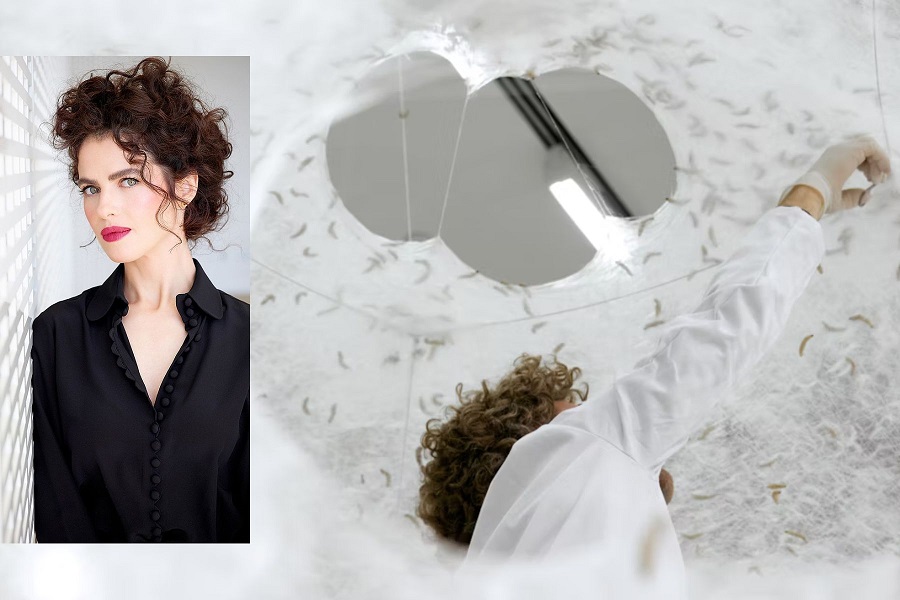ISABEL RUBIO ARROYO | Tungsteno
The Silk Pavilion I is an architectural structure created with a base woven by a robotic arm and the help of thousands of live silkworms. "We ordered 6,500 silkworms from an online silk farm. After four weeks of feeding, they were ready to spin with us," says Neri Oxman, the leader of the initiative. We investigate the most innovative projects of this 48-year-old Israeli-American architect, known for fusing architecture, design, biology and materials engineering.
From Henry Ford to Charles Darwin
Assembly lines have dictated a world made of parts, "framing the imagination of designers and architects who have been trained to think about their objects as assemblies," says Oxman. In contrast, the architect argues that assemblages of homogeneous material are not found in nature. She cites human skin as an example. "Our facial skins are thin with large pores. Our back skins are thicker, with small pores. One acts mainly as a filter, the other mainly as a barrier, and yet it is the same skin: no parts, no assemblies," she said in a TED talk.
Architects and designers face a dichotomy: that of working between the machine and the organism. Or as Oxman puts it, "between the chisel and the gene, between machine and organism, between assembly and growth, between Henry Ford and Charles Darwin." "My work, at its simplest level, is about uniting these two worldviews, moving away from assembly and closer into growth," she explains.
Oxman explores how digital fabrication technologies can interact with the biological world. Credit: TED
More than 6,000 silkworms weave the architecture of the future
It is in this fusion that one can understand her Silk Pavilion I, in which biological silk and robotically spun silk intermingle. To construct it, she and her collaborators carefully placed 6,500 worms on the bottom edge of a silk frame spun by a robotic arm. The silkworms spun their silk, mated and laid eggs. In little more than two to three weeks, "6,500 silkworms weave 6,500 kilometres."
In this work, her two visions of the world are integrated: "One spins silk out of a robotic arm, the other fills in the gaps." "If the final frontier of design is to breathe life into the products and the buildings around us, to form a two-material ecology, then designers must unite these two worldviews," she says.
Later, the architect and her team developed the Silk Pavilion II. Commissioned for the Material Ecology exhibition at the Museum of Modern Art in New York, the structure is six metres high and five metres wide. "Ten days of co-creation among silkworms, humans and a robotic loom-like jig resulted in a structure made of silk threads longer than the diameter of planet Earth," explain its creators.
More than 6,000 worms were involved in the construction of the Silk Pavilion. Credit: Oxman
Fallen leaves, apple skins and shrimp shells
Oxman has become a prominent figure in the field of material ecology. This discipline integrates technological advances in computational design, synthetic biology and digital fabrication to create revolutionary design solutions inspired by nature. Her team in the Mediated Matter group at the MIT Media Lab experiments with everything from moss to mushrooms to apples.
One of her most striking projects is Aguahoja I, which aimed to develop a robotic platform for 3D printing biomaterials. The result is a pavilion made of 5,740 fallen leaves, 6,500 apple skins and 3,135 shrimp shells. Also noteworthy is her synthetic apiary, which aims to combat the decline of bee populations. This initiative proposes the creation of controlled, indoor environments that simulate ideal conditions for bees to thrive throughout the year.
Oxman's work has been seen on fashion catwalks and at design fairs. They have also been exhibited in prestigious museums around the world, including the Museum of Modern Art and the San Francisco Museum of Modern Art. In addition to winning several awards (including the Cooper Hewitt Design Award and the Vilcek Prize in Design), her creations led Jenny Lam, a leading technology designer, to describe Oxman as a contemporary Leonardo da Vinci.
Tungsteno is a journalism laboratory to scan the essence of innovation.
